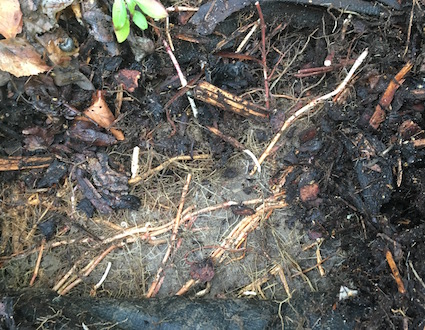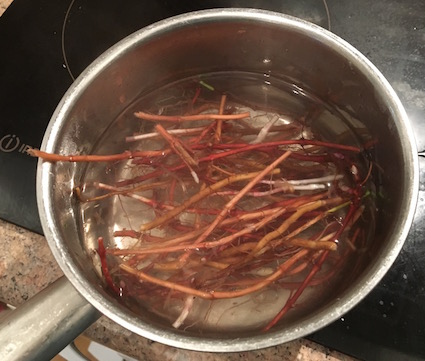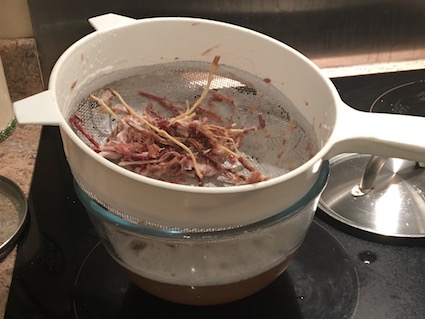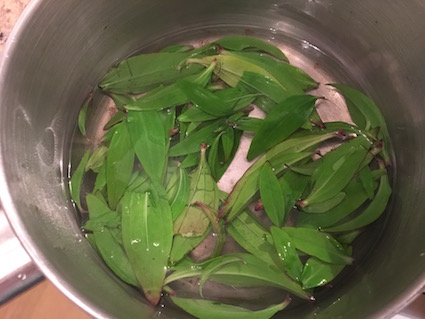
Whilst in Hong Kong, I stayed at the Ark Eden Project. Being an environmental organisation, the focus is on living lightly. Outside the compost toilet, the hand washing facilities consisted of a small bowl of soapberries. These were used in place of soap. It reminded me that I have soapwort – Saponaria officinalis – growing in my garden as a weed. Some people know it as “Bouncing Bet”.
So one of my projects upon my return has been to finally research and use the soapwort as a natural alternative to standard soap, shampoo and detergent. It is still growing and flowering at this time of year which has been handy (forgive the pun).

From my online search for information plus looking at Roger Phillip’s book, Herbs, there seemed to be mixed advice. Roger advocates the use of the roots. Other sources suggested the leaves. Naturally this called for a little experimenting. Soapwort is a perennial plant and its root system has invaded all my front garden so collecting a few roots from underneath the mulch mat was very easy. I gave these a thorough wash, scrub and trim in cold water before following Roger’s advice to boil them for 4 or 5 mins before using.

The roots after this treatment lathered beautifully. I could take clumps of roots and use them to wash my hands. They worked after getting my hands dirty. When a little cooking oil landed on my hands, the roots and water removed the oil.
So I decided to go all out and experiment further. The sieved soapwort lotion was left overnight. The following morning I reheated it and washed my hair with it. Now this was a strange sensation. It cleaned my hair but not in that squeaky clean way. No-one seemed to notice any difference but my hair did feel very soft.

The leaves were my second investigation. To begin with I took a couple of leaves and tried using them with cold water. The leaves lathered but also produced lots of chlorophyll so it was a very green wash. What was more successful was leaving the leaves to steep in warm water for a minute or two first of all. They lathered but without the chlorophyll residue.

All-in-all it was a very enjoyable activity. Whilst I won’t be rushing out to the garden on a daily basis, it’s definitely made me think about how much children would enjoy this investigation. It’s simple, has a purpose and would be doable over a campfire as all that’s required is a little warm water. Alternatively a flask of warm water would suffice for hand washing purposes.
More recently, I’ve come across a method for using horse chestnuts – conkers for producing a natural detergent too. But I’ve yet to try this out.
Any further advice would be welcome – I’d love to know if you’ve tried using soapwort or other plants in place of soap and what you discovered. Perhaps I need to try washing clothes now… 🙂
This blog post was originally published in October 2016 but was last updated during October 2024.




















Thank you for this post. I use soapnut shells all the time for handwashing and washing the dishes and laundry but of course I have to buy them because they won’t grow in UK climate, so I’ve been wanting to try soapwort instead. Thanks for sharing your experiment.
In place of washing up liquid I put 6 whole (or 12 half) soapnut shells into a jar of water and let them soak for at least twenty minutes, or preferably overnight, and then tip the whole jar – water and shells – into your washing up bowl and add hot water. It will lather up beautifully. Take the shells out of the bowl when you’ve finished and return them to the jar with some more clean water. They’ll be good to use one or two more times. Then compost them. Can do the same for a liquid hand-wash. Just put 6 soapnuts in an old (cleaned) plastic water or pop bottle (you don’t have to buy one as people are always littering them (!)). Fill it with water. Pierce holes in the top of lid (careful!). Leave to stand for a few days. Then stand it on the side of your sink ready for hand washing. Hands will lather better on second wash so lather, rinse repeat! 😀
Hi Violet – it’s good to hear about your soaqpnut experiences… soapwort is a thug of a plant so when you get some, it’s probably best to put it in a container – but this is a good thing if you are serious about using it all the time.